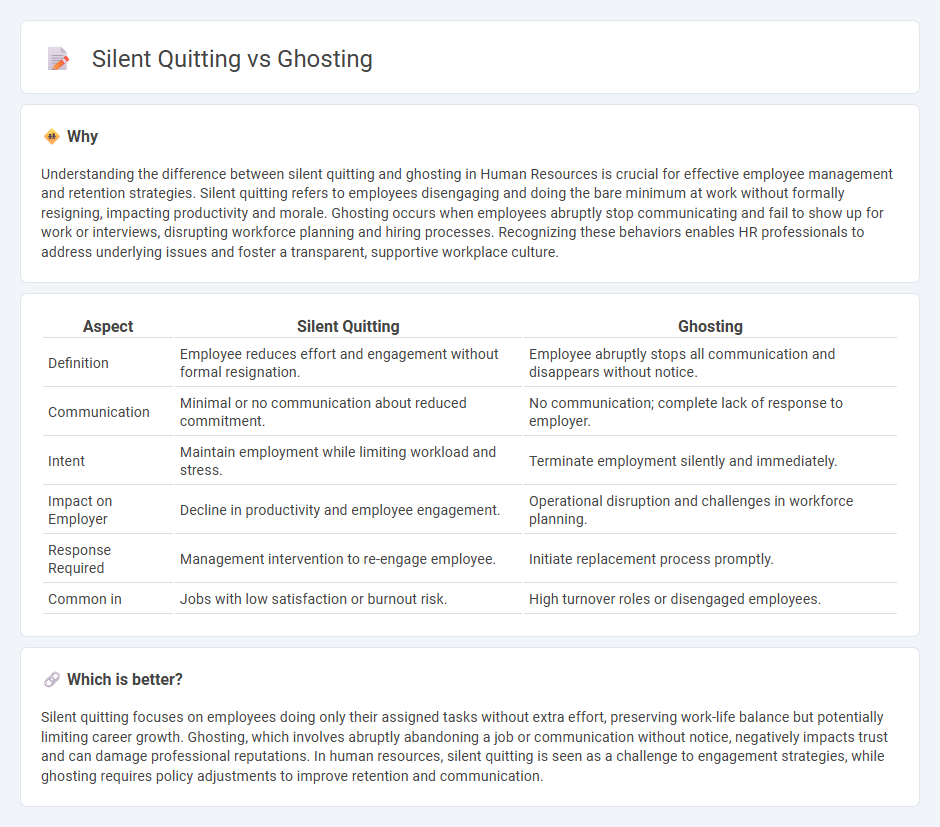
Silent quitting refers to employees doing the bare minimum at work without formally resigning, while ghosting occurs when employees abruptly stop communicating and fail to show up without notice. Both phenomena present significant challenges in human resources management, affecting productivity and team morale. Explore our detailed analysis to understand how organizations can address and prevent these workplace issues.
Why it is important
Understanding the difference between silent quitting and ghosting in Human Resources is crucial for effective employee management and retention strategies. Silent quitting refers to employees disengaging and doing the bare minimum at work without formally resigning, impacting productivity and morale. Ghosting occurs when employees abruptly stop communicating and fail to show up for work or interviews, disrupting workforce planning and hiring processes. Recognizing these behaviors enables HR professionals to address underlying issues and foster a transparent, supportive workplace culture.
Comparison Table
| Aspect | Silent Quitting | Ghosting |
|---|---|---|
| Definition | Employee reduces effort and engagement without formal resignation. | Employee abruptly stops all communication and disappears without notice. |
| Communication | Minimal or no communication about reduced commitment. | No communication; complete lack of response to employer. |
| Intent | Maintain employment while limiting workload and stress. | Terminate employment silently and immediately. |
| Impact on Employer | Decline in productivity and employee engagement. | Operational disruption and challenges in workforce planning. |
| Response Required | Management intervention to re-engage employee. | Initiate replacement process promptly. |
| Common in | Jobs with low satisfaction or burnout risk. | High turnover roles or disengaged employees. |
Which is better?
Silent quitting focuses on employees doing only their assigned tasks without extra effort, preserving work-life balance but potentially limiting career growth. Ghosting, which involves abruptly abandoning a job or communication without notice, negatively impacts trust and can damage professional reputations. In human resources, silent quitting is seen as a challenge to engagement strategies, while ghosting requires policy adjustments to improve retention and communication.
Connection
Silent quitting and ghosting both reflect disengagement trends in Human Resources, where employees withdraw effort or communication without formal resignation. Silent quitting involves reduced work commitment and minimal task completion, while ghosting entails abruptly ceasing all contact with employers. These behaviors challenge traditional retention strategies, highlighting the need for proactive employee engagement and transparent workplace communication.
Key Terms
Employee Engagement
Ghosting refers to employees abruptly ceasing all communication and interaction with employers without notice, significantly undermining trust and overall employee engagement. Silent quitting involves employees doing the bare minimum at work, disengaging emotionally while maintaining appearances, which gradually erodes team productivity and morale. Explore deeper insights into how these behaviors impact workforce motivation and retention strategies.
Communication Breakdown
Ghosting involves an abrupt cessation of communication without explanation, often leaving the other party confused and seeking closure. Silent quitting, however, manifests as a gradual withdrawal from engagement and effort while still maintaining minimal interaction, signaling disengagement without open confrontation. Explore deeper insights into these communication breakdowns and their impacts on personal and professional relationships.
Retention Strategies
Ghosting refers to employees abruptly leaving without notice, while silent quitting involves reduced engagement without formal resignation; both behaviors significantly impact retention strategies by signaling disengagement and dissatisfaction. Effective retention approaches include transparent communication, proactive feedback mechanisms, and fostering a supportive workplace culture to address underlying issues. Explore comprehensive retention strategies to minimize ghosting and silent quitting in your organization.
Source and External Links
Ghosting (behavior) - Wikipedia - The practice of suddenly ending all communication with someone without explanation or warning, commonly used in personal and professional contexts.
What is Ghosting and How Not to Do It | Bumble - Ghosting occurs when someone ceases all contact with you and disappears without giving any reason, typically after some prior interaction.
Ghosting | Psychology Today - Ghosting is the abrupt cessation of communication with another person without explanation, most often associated with romantic relationships.
 dowidth.com
dowidth.com